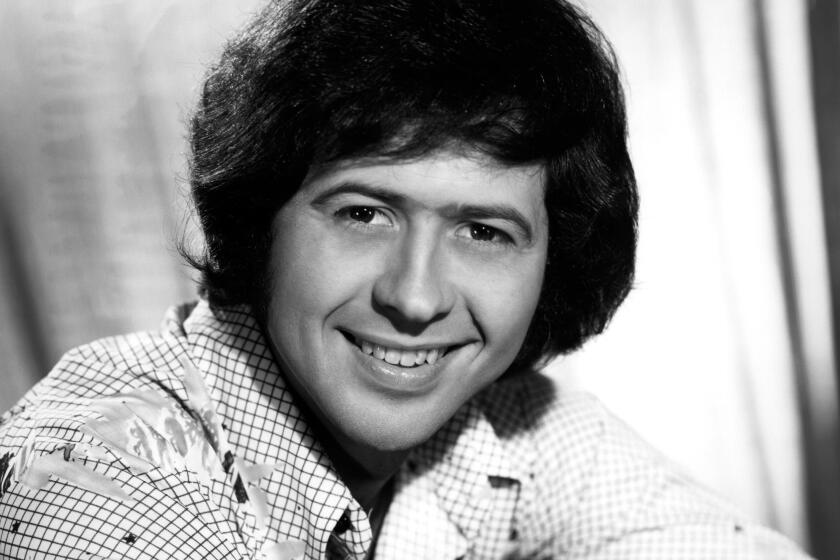As if by market research
In the 1990s, the Russian conceptual art team Komar and Melamid created a bunch of paintings based on extensive market research, asking people from various countries what they favored. America’s “most wanted” painting was a watery landscape featuring wistful children, deer and George Washington. Komar and Melamid parted ways in 2003, but not before also creating (with composer Dave Soldier) a “most wanted” pop song, a discouraging mix of quiet storm R&B; and roadhouse rock.
Confronted by this year’s Grammy nominations -- especially the four “general field” categories -- I wondered if Komar and Melamid had reunited. The list abounds with deserving contenders, some expected, some from beyond left field. It shows discernment and even a bit of daring on the part of the Recording Academy. But as an indicator of how music is currently operating as a unifying force or even a simple pleasure, it’s a disconcertingly ersatz mix.
Album of the year offers the strangest grouping by far. It’s weird because it feels so calculated. Those included are all utterly deserving -- in fact, the biggest surprises, Vince Gill and Herbie Hancock, are as classy as Grammy nominees get. But the sharing of the bill among those two artists and Kanye West, the Foo Fighters and Amy Winehouse represents a fantasy iPod playlist that turns the idea of eclecticism from an adventure into something, well, preprogrammed.
Gill is a well-loved country gentleman whose four-disc “These Days” was a self-generated encyclopedia of the genre. West is hip-hop’s official maverick, known for mouthing off but not for getting arrested. The Foo Fighters, fronted by the notoriously nice Dave Grohl, have turned alt-rock into classic rock.
Winehouse is an indisputable vocal talent whose personal troubles often overshadow the essential conservatism of her “retro” soul style. And Hancock is a jazz pathfinder whose outstanding “River: The Joni Letters” nonetheless offers many listeners a nostalgia trip, since it reworks the music of fellow baby boomer royal Joni Mitchell. Hancock is the George Washington in this painting, the unexpected figure who, when you think about it, has the bearing and the historical weight to make him inevitable.
There is absolutely nothing wrong with this bunch. That’s what’s a bit maddening about it. In the past, the Grammys have often been accused of pandering to the milquetoast mainstream, its endorsements of bland balladeers causing groans among serious fans and critics. More recently, a broader-based nominating committee has made for some spicier nominees -- the hip-rock duo Gnarls Barkley, a double winner last year, was one such happy choice.
But the groans have become part of what makes the Grammys fun and intriguing; they represent the ground truths of American music, the stuff that wins the hearts of the great, mysterious mainstream. And the cheers have brought the awards into the future, showing that the very idea of mainstream is becoming more complex and inclusive.
This year, though, polite hand-clapping feels more appropriate. Beyond album of the year, the other general categories overflow with beautifully crafted, inescapable hits, many produced by the R&B-rooted; songwriting teams that are creating a new, virtual Brill Building stretching from Atlanta to Norway. (A bit of modern rock is thrown in here and there for the middle-aged set.)
It’s thrilling that women dominate the best new artist slot (go Feist!), but even that shift generates a kind of abstract excitement, not the kind that comes from watching the ascent of artists who really shake up the pop scene, musically or through the force of their personalities.
The civilized diversity of this year’s general nominations represents a music culture in violent and seemingly unceasing flux -- in so much flux, in fact, that we’re all tired of talking about it -- putting its best, most elegant face forward. In many small ways, it’s an exciting slate. Yet it intrigues in such a quiet way, one that speaks of an industry turning inward, and a listenership based less on passion than good taste. It’s a beautifully designed picture, one that can’t help but inspire some hope that somebody will soon come along to put a big slash in it.
More to Read
The biggest entertainment stories
Get our big stories about Hollywood, film, television, music, arts, culture and more right in your inbox as soon as they publish.
You may occasionally receive promotional content from the Los Angeles Times.










